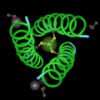It's true. Chimeras are out and walking among us. These aren't quite the chimeras that RPM is obsessed with, but they're certainly bothersome to some.
From Genome Technology Online, we have a report that James Derr, at Texas A&M College of Veterinary Medicine, wants to sequence the genome from a real buffalo, but those buffalo are hard to find.
To quote Genome Technology:
Problem is, that legacy has been mingled with domestic cattle in efforts to "make a better beef animal." Meatier, more docile hybrids are known as cattelo, if you were wondering.
Where do real buffalo roam?
Maybe not on the range.
More like this
Ask yourself: What's the best way you can promote atheism in your community or on your campus?
My quick little jaunt up to Buffalo ended up being not so quick. The plan was to fly up on Friday, do my thing on Saturday, then fly back on Sunday. Quick and painless!

These are hybrids not chimeras . . .
Let the debate over semantics begin!
And I'm obsessed with manatees, not chimeras. That is, unless the matatees devise some sort of manatee/lobster chimera. That would really freak me out.
Two things about that story don't make sense to me.
First, sterility has always been a significant problem in cow-buffalo hybrids. Standard evolutionary theory says that a tendency toward sterility is a detrimental trait and will be driven out of the population in a relatively short time. Under those conditions, how could the hybrid genes achieve such widespread penetration of the overall population?
Second, what genes were they using to detect the presence of cattle ancestry? Is it possible that one or more of the "cattle" genes isn't really a diagnostic for cattle ancestry, but is rather a naturally-occurring variant within the wild buffalo population?
According to the New York Times article, only 10,000 out of 300,000 bison are actually pure bison. So almost all bison are cattle-bison hybrids to some extent, except for the herds in Yellowstone, Wind Cave National Park, and a few others.
As far as evolution goes, the only offspring from a cattle-bison cross that can reproduce are those that are fertile. There may be some sterile offspring, but they won't contribute anything to future populations since they can't reproduce.
Both cattle and bison have 30 chromosomes, with about 25,000 or so genes, so I'm sure there are plenty of cattle genes that don't affect fertility, and vice versa.
The New York Times quoted James Derr, from the Texas A&M University, as saying that,
I suppose that helps explain, in part, why the hybrids are so prevalent.
Now, for the question of how they're testing for cattle genes. I looked up some of the papers in PubMed. It looks like the people who are studying the genetics of bison have been working on this for quite a few years and have developed tests that look pretty good. I will write more the tests a bit later.